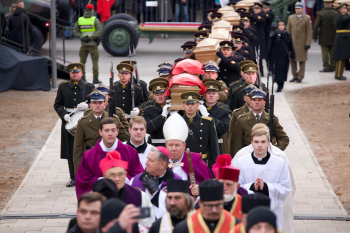The ceremony of the State Funeral for commanders Zygmunt Sierakowski and Konstanty Kalinowski and 18 other participants of the 1863-1864 uprising, whose remains have been unearthed in Gediminas Hill, was held on 22 November 2019.
There was a public farewell in the Cathedral Basilica of St. Stanislav and St. Vladislav, with the participation of state officials and foreign delegations from the neighbouring states. A Holy Mass was celebrated by Metropolitan Archbishop of Vilnius, Gintaras Grušas. Farewell speeches were given by H. E. President of the Republic of Lithuania Gitanas Nausėda, H. E. President of the Republic of Poland Andrzej Duda and Deputy Prime Minister of the Republic of Belarus Igor Petrishenko.
The commanders and participants of the 1863-1864 uprising were buried in the Chapel of the Old Rasos Cemetery, whereto the coffins made their way in a funeral procession through the streets of Vilnius.
The Chapel has been open to the public from 16.00 to 24.00 on 21 November, and from 9.00 to 21.00 on 23-24 November. For the sake of safety, visitors have been requested not to bring candles into the Chapel.
The 1863-1864 uprising continues, to this day, as a subject for academic research, public and political debate, and as a museum and artistic quest. The core idea behind the uprising – the struggle for Freedom – had paramount importance for all the nations that fought against the Russian Empire.
Gediminas Hill reinforcement works, which began on 3 January 2017, happened to accidentally unearth burial sites. Following the identification of the remains of the participants of the 1863-1864 uprising, executed in Lukiškės Square in Vilnius, the search efforts continued and finally resulted in the excavation of 20 human remains. It was decided that the State Funeral for the commanders and participants of the 1863 uprising should be held, in cooperation with Poland, on 22 November, with the reburial taking place at the Rasos Cemetery in Vilnius.
Accompanying events
The National Museum of Lithuania is running an exhibition featuring the lives and the tragic fate of the participants of the 1863-1864 uprising from 21 November to 31 May 2020. The Museum has also presented two books related to the 1863-1864 uprising. ‘Memoirs’ by Apolonia Dalewska-Sierakowska, wife of one of the commanders of the uprising is an ode to selflessness, devotion to the homeland, faithfulness and sacrifice. It has been translated into Lithuanian. The other book ‘Road of 1863-1864 insurgents to death and rebirth’ tells, for the first time, the story of the dramatic events in Lukiškės Square.
To commemorate the 1863-1864 uprising, Vilnius Picture Gallery of the Lithuanian Art Museum (Chodkevičiai Palace, Didžioji Street 4) has opened up an exhibition ‘Artur Grottger. ‘Lituania’. 1863-1864 uprising in Lithuania’ to run until 26 January 2020.
On 22 November, at 6.30 p.m., the Students’ Corporation ‘RePublica’ held a public discussion ‘Three Nations: One Memory?’ at the Institute of International Relations and Political Science, Vilnius University, (Vokiečių Street 10, Room 402), which focused on the role of the uprising in historical and modern discourses in Lithuania, Poland and Belarus.
